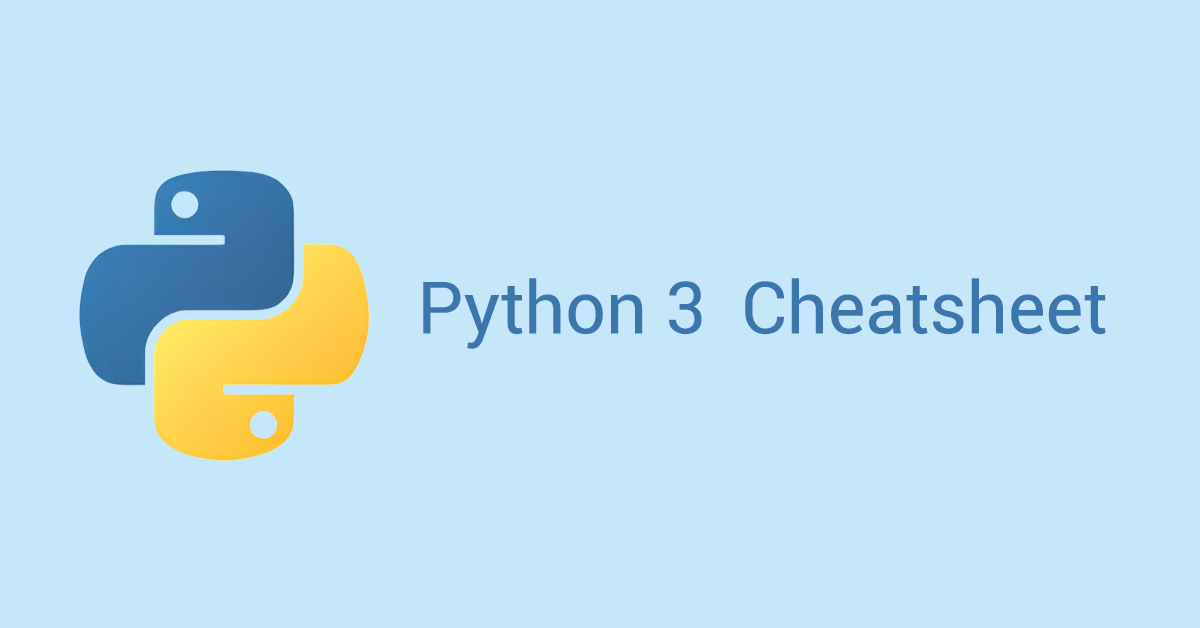Are you new to Python programming or just need a handy reference guide? Look no further! In this blog post, we’ve compiled a comprehensive Python 3 cheat sheet that covers the essential concepts, syntax, and techniques to help you navigate the world of Python programming. Whether you’re a beginner or an experienced developer, this cheat sheet will serve as a quick and informative reference.
Python Basics
Comments
Let’s start with comments, single line comment as shown below:
# This is a single-line comment
Multiline comment as shown below :
'''
This is a
multi-line
comment
'''
Variables
variable_name = value
Example :
age = 25
name = "Tom"
Here age and name are variables. Python variables are dynamically typed, so they can hold any type of data.
Data Types
Python 3 has following data types:
- int: integers
- float: floating-point numbers
- str: strings
- bool: boolean values (True/False)
- list: ordered collection of elements
- tuple: ordered, immutable collection of elements
- dict: key-value pairs
- set: unordered collection of unique elements
Control Flow
Conditional Statements
if condition:
# code
elif another_condition:
# code
else:
# code
Loops
Python 3 supports the following loops.
For loop
for item in iterable:
# code
While Loop
while condition:
if some_condition:
break
elif another_condition:
continue
Learn more about Python loop syntax
Functions
Defining Functions
def function_name(parameters):
# code
return result
Lambda Functions
Lambda functions are anonymous functions created using the lambda keyword.
lambda arguments: expression
Example :
lambda x, y: x + y
Scope
- Variables defined within a function are local to that function.
- Variables defined outside functions are global.
Data Structures
Lists
fruits = ["apple","oranage","banana"]
Tuples
days= ("Sunday", "Monday", "Tuesday","Wednesday","Thursday","Friday","Saturday")
Dictionaries
my_dict = {
'key1': 'value1',
'key2': 'value2'
}
Example :
person = {
'name': 'Tom',
'age': 30
}
Sets
my_set = {item1, item2, item3}
Example :
my_set = {1, 2, 3}
File Handling
Opening Files
file = open('filename.txt', 'mode')
Modes :
'r': Read'w': Write (creates a new file or truncates an existing one)'a': Append'b': Binary mode'x': Exclusive creation (fails if file already exists)
Reading from a File
content = file.read()
Writing to a File
file.write("Hello, File!")
Exception Handling
Try-Except Blocks
try:
# code
except SomeException:
# code
else:
# code (runs if no exception)
finally:
# code (always runs)
Raising Exceptions
raise SomeException("An error occurred")
Modules
Importing Modules
import module_name
from module_name import some_function
Creating Modules
- Create a
.pyfile and define functions and variables. - Use
importto use the module in other scripts.
Object-Oriented Programming
Classes and Objects
class MyClass:
def __init__(self, param):
self.attribute = param
def some_method(self):
# code
Inheritance
class ChildClass(ParentClass):
# code
Useful Built-in Functions
len(iterable): Returns the number of items in an iterable.range(start, stop, step): Generates a sequence of numbers.type(object): Returns the type of an object.str(object): Converts an object to a string.
Virtual Environment
Creating a Virtual Environment
python3 -m venv env_name
Activating a Virtual Environment
- Windows:
env_name\Scripts\activate - Linux/Mac:
source env_name/bin/activate
Useful Libraries (Install with pip)
- NumPy: Numerical computing library.
- Pandas: Data manipulation and analysis library.
- Matplotlib: Data visualization library.
- Requests: HTTP library for making API requests.
- Beautiful Soup: HTML parsing library.
- SQLAlchemy: SQL toolkit and Object-Relational Mapping (ORM) library.
Remember, this cheat sheet is designed to provide a quick overview of Python 3 concepts and syntax. For more detailed explanations and examples, be sure to refer to the official Python documentation and other learning resources. Happy coding!
